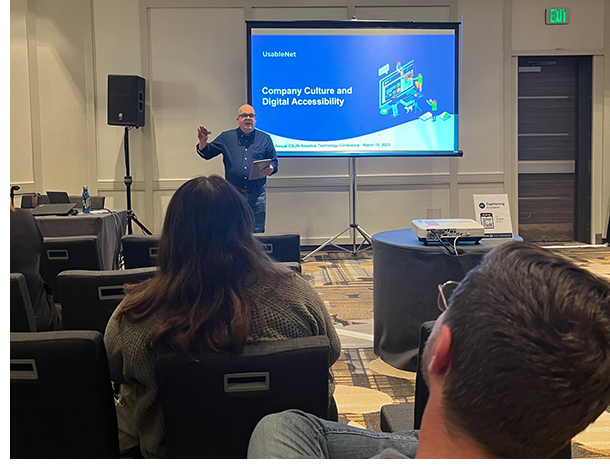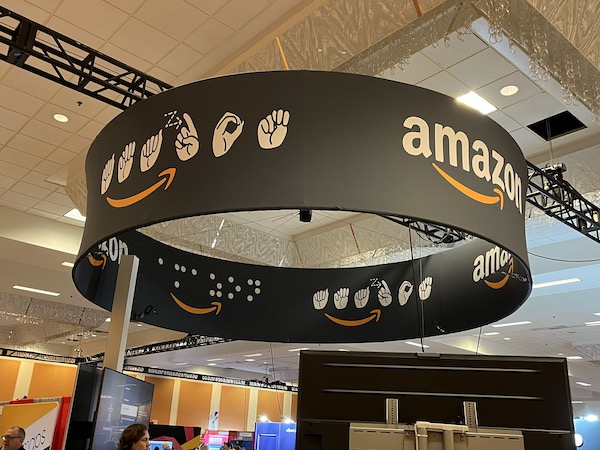During the week of March 13, I attended the 38th Annual CSUN Assistive Technology Conference in Anaheim, California. CSUN is short for California State University Northridge, and that campus has a Center on Disabilities that is “committed to the vision of an inclusive society where people of all abilities have the chance to achieve their goals and experience success. Through excellent training and research, we nurture learning and innovation to improve the world for people with disabilities.” CSUN has put on this conference since 1985, five years before the Americans with Disabilities (ADA) Act passed.

I attended as part of my work with UsableNet, and several colleagues, including Michele, were also there. It was a week of great conversations and learning. I also delivered a session about company culture and digital accessibility, which focused on how people can advocate for their workplaces to have an accessibility first mindset. This was my first time to speak at a conference of this nature, and my anxiety was quite high in the hours leading up to it. But the session went over well, which I’m happy about.
I’d like to share three things from the conference that creatives should find interesting.
What an Accessible Event Includes
Making sure attendees could access the conference’s information in whatever way they needed to was a part of every session.

This image is from the keynote address. The speaker is at the podium, using a microphone. There are large captions displayed on a screen, along with a video feed of a person providing the American Sign Language (ASL) interpretation. The speaker is also on a screen, which allowed also for lip reading.
Even in sessions that were not on the main stage, there were occasionally ASL interpreters in attendance (I believe audience members could request ASL interpreters to be in rooms when needed). Presenters were told to always use the room’s microphones so the audio could be available to live caption and assistive listening devices. The presenters also spoke the material that was displayed on screen.
These actions helped ensure that all attendees felt included in the presentations. I would love to find similar at other conferences, whether they are in person, online or hybrid.
Accessibility for Amazon Kindle
Amazon sponsored and exhibited at the conference and I got to find out about the accessibility tools that are available in Kindle, some of which I knew and some I didn’t.

Let me share with you what’s available on a Kindle device in case you aren’t already aware (some of these aren’t available on all devices and apps):
- Multiple fonts to choose from.
- Adjustable font size.
- Adjustable screen brightness, as well as dark mode.
- Adjustable background color
- Adjustable margin width and line spacing
- Four standard page themes, including compact, standard, large, and low vision. Plus, you can save your own custom theme with the settings that you choose.
- Text-to-speech so the device can read the book text to you. I use this all the time, sometimes reading along with the voice, and other times putting the tablet aside and simply listening. I enjoy having the options available so that I can read however I want in the moment.
- The option to turn pages using the volume controls instead of swiping left and right, or to have a continuous scroll that moves up and down, instead of left and right.
- The Reading Ruler, which is available on books that are enabled with Enhanced Typesetting. This helps with reading focus and concentration by allowing the reader to move vertical bars on the page as they read. This was a new feature for me and I tried it out and I definitely saw the advantages of using it to help focus your eyes on the page. It comes with many customizations as well.
It’s great to see so many options for accessible reading on Kindle devices and apps. Amazon also showed accessibility features on other devices as well, including Fire TVs and Alexa devices.
EPUB3 and Accessible EPUBs
I’m going to write a dedicated blog post on this topic in the coming weeks, but I wanted to touch on this now as I’ve seen a few authors already talking about the European Accessibility Act (EAA), which has requirements for accessible ebooks, as well as reading devices and the ecommerce that supports that. Those requirements are to be enforced by the end of June 2025.
I went to a couple of sessions given by The DAISY Consortium, which is an organization with the mission “to develop global solutions for accessible publishing and reading, in partnership with civil society, publishing and technology industries, standards bodies and governments.”
At the sessions, I learned about the EPUB3 standard, the latest version that’s due out this year, and the accessibility components of that standard. I learned about the DAISY tools that are available as well, both of which are free:
- EPUBCheck: Checks to make sure an EPUB file conforms to all aspects of the EPUB standard. Your ebook files are already going through EPUB checks when you upload to the various ebook platforms, so this isn’t necessarily one you need to run before that upload.
- Ace by DAISY: Checks the accessibility of EPUB files. I don’t believe at this point (and I’ll confirm in the future) that this check is being performed on file upload, so this is something you can check for yourself using this tool that you can download for Mac and PC.
I ran my first accessibility check on Content for Everyone, which also is the first book I’ve generated with EPUB3 (which is an option available in Vellum). It passed the check with no issues. I then ran an EPUB2 book through the checker and it had an accessibility issue. I’d already planned to update my books to EPUB3 soon as I need to update some material across my backlist, so that issue will get sorted out.
The next big test for my books, and really all ebooks, is when the EPUB 3.3 standard rolls out later this year.
As I mentioned, I’ll be doing a full post on EPUB3 and the accessibility standards soon. In the meantime, if you want to see the status of your books, you can download Ace by DAISY and check. I’d also recommend updating to the EPUB3 standard sooner than later so your books are following the latest standard.
